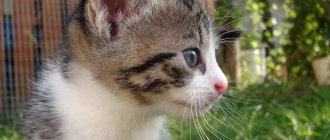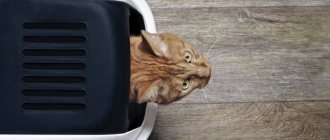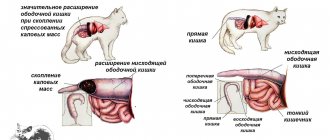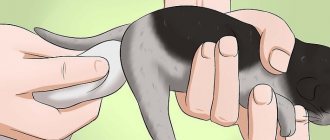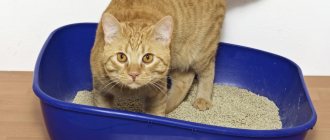Feline hyperesthesia syndrome, which causes discomfort in cats, causes increased skin sensitivity.
Feline hyperesthesia syndrome is also often called twitching skin syndrome, twitching cat syndrome, rolling skin syndrome , atypical neurodermatitis, psychomotor epilepsy and neuritis. No matter what you call it, it's a condition that causes your kitty to experience increased skin sensitivity, so you can imagine how uncomfortable it can be.
Read the information below to learn more about feline hyperesthesia and what you can do if your cat has been diagnosed.
Attracts attention
Cats are social animals. They need enough human interaction. Having run around, the cat will calm down and go to rest in its favorite place. Nowadays, it is rare for people to have several pets at once, so you should devote enough time to your only furry pet. Moreover, he himself will let you know when he loses interest in communicating with the owner.
How to help your pet
In most cases, this behavior of cats is completely normal and natural; they do not need any help . When it is difficult for a cat to go to the toilet in a big way (constipation) and he clearly experiences pain or discomfort, you should show him to the veterinarian, as this may be a symptom of some disease. The presence of bloody inclusions in the stool should cause particular concern.
Your cat may be constipated
If everything is in order with the waste products, they have normal consistency and color, then there should be no cause for concern. There is no need to calm your pet before defecation and you should not pay attention to his madness.
Shape matters
The cat's “fifth limb” can have different configurations and lengths:
- the Thai has an oblong thin tourniquet (25-35 cm);
- the Persian has a short, luxurious fan (20-25 cm);
- the bobtail has a short, almost round pompom (5-13 cm);
- the Cymric has a barely noticeable stump (2-5 cm).
Moreover, in all cats, the tails consist of several (from 2 to 27) vertebrae, connected by a jelly-like joint fluid. The presence of “lubricant” explains, from a biochemical point of view, why cats wag their tails.
The shape of the outermost caudal vertebra is fundamentally important for the exhibition life of representatives of the cat family. The slightest deformation - knot formation, bending, kink, crease - will not allow the meowing contestant to pass the strict judicial selection.
Overexcited
Often, as a result of active games with the owner, the cat can become overly excited, and it takes some time for him to calm down after this.
Therefore, the pet can behave hyperactively for quite a long time after the end of the game itself. If cases recur without the owner's participation, you should visit a veterinarian. Cats, like people, can suffer from nervous system disorders. Now there are many ways to bring an animal back to normal.
Why does a cat run around the house before going to the toilet?
Many owners have noticed inappropriate behavior of their pets before doing their thorough business in the toilet. They begin to run, making circles throughout the house. In this case, not only horizontal surfaces can be used, but also vertical ones, for example, curtains. Some especially talkative individuals emit heart-rending screams of varying degrees of intensity, depending on their temperament.
Cats often rush around the apartment before going to the toilet in a big way.
Unfortunately, the cats themselves cannot explain their unusual behavior before going to the toilet to us, so we can only make more or less logical assumptions. There are several versions:
- Physical activity, during which the abdominal muscles contract, stimulates intestinal function. As a result, peristalsis improves, and the process of releasing feces is easier.
- The tray is dirty, smells bad, or there is not enough filler. The pet signals that it would be nice to clean his potty.
- The act of defecation itself is painful for the cat, so he worries and screams.
- The animal warns its owners in advance about the upcoming cleaning of its toilet.
The restless behavior of cats before going to the potty can be caused by behavioral characteristics, since they mark their territory not only with urine and secretions, but also with feces. Wild cats leave fragrant heaps along the borders of their territory. Rushing around the house, the pet declares itself the master of this area, but since it is strictly forbidden for it to shit anywhere, it does all the necessary activities in the place designated for this (tray).
Active movements help the intestines work better
Our cat, before leaving to accomplish great things, always begins to look into her eyes, while meowing pitifully, and asking to go outside (where she is not allowed). This action can last for a different amount of time (from 5 minutes to an hour), apparently, it depends on the degree of fullness of the intestines. Realizing that everything is useless and it will not be possible to break into the street again, the kitty goes to the potty and does his “dark” things there. Then he happily runs around the rooms and tears at the carpet with his claws.
Symptomatic diet and procedures
To ensure that itching bothers your cat as little as possible, prevention is important. Experts recommend adhering to the following simple rules:
- The animal needs to be provided with healthy, balanced food. For these purposes, it is better to use specialized food.
- The cat should not be fed smoked meats, sausages, or junk food from the table.
- Regularly brush your cat, remove hair mats, and inspect the surface of the animal’s skin.
- Once every six months, treat the fur against parasites (relevant for animals that at least occasionally go out for a walk).
- Do not allow your cat to come into contact with street animals.
- Avoid situations in which your cat can taste or smell household chemicals.
- In case of insect bites, promptly treat the bitten area.
- Once a week, inspect your cat’s ears for mites and inflammation.
If a cat scratches and chews itself, this is not always bad. The desire to scratch is natural for animals. You should pay attention to your pet when scratching begins to interfere with a full life. Timely treatment will help your cat recover faster and prevent unpleasant complications associated with endless itching.
Wants to “walk”
This applies to variants of absolute norms. The cat's natural desire to continue its breed can result in overly active behavior. Females also ask for a cat with a certain frequency. There are 2 solutions here:
- regular use of hormonal medications;
- castration or sterilization.
Owner's behavior after surgery. Surgical removal of genitalia procedures are performed quickly. But recovery will take some time. During this period, the animals are too weak and need special attention from the owner.
It is unacceptable to leave pets after surgery with sources of possible dangers, in particular water.
The toilet lid should always be down. Other containers must also be closed. In addition, it is important to take care of a balanced diet and avoid the development of obesity.
Why do cats leave home?
Often, owners perceive an animal’s desire to leave its habitable place as a sign of impending disaster. It is no secret that these mysterious creatures have always been considered strongly connected with the other world. The logic is simple: since the cat ran away from the house, it means that some kind of misfortune must soon befall him. Until the death of one of the owners.
However, do not rush to wring your hands in despair and distribute personal property among the heirs. Another version of the sign explains the behavior of the animal in a completely different way. Misfortune really threatened your family, but the sensitive four-legged guard found out about it in time and took it away from the house. So there is no need to blame a devoted animal for trying to save its own skin! Perhaps your pet protected you from something truly bad by voluntarily taking on the danger. There is no need to even try to ward off a bad omen. The cat has already done everything necessary for you.
What if your pet left you to protect you?
Many consider it an extremely bad sign for a cat to disappear from a house in which there is a seriously ill person. It seems that the poor fellow's days are numbered; and if the sick person himself is subject to various prejudices, his condition actually begins to rapidly deteriorate. But the event can be assessed in a positive way! Let us assume that the cat does not prophesy death, but takes it with it. Of course, I feel sorry for my dear purr to the point of tears. But instead of indulging in fears, thank her for her kindness and wait for the patient to recover. The sooner he believes it himself, the greater his chances of getting out of bed.
The third option suggests: by leaving, the animal made room for someone else. Your family is expecting not losses, but additions! Are you or someone in your immediate family planning to have a baby?
The belief gives cats of different colors special abilities. So, the black one protects the house from evil spirits, the red one brings love, the gray one strengthens well-being, the white one heals and harmonizes the situation in the family, and the tricolor one promises a whole flurry of good changes. But don’t think that the disappearance of a red cat will erase romantic relationships from your life, and the departure of a white cat predicts illness. In this case, the color, as well as the gender of the animal, do not matter.
Scientific point of view
The loss of a furry pet should not always be taken as a sign of changes in life. Animal lovers who are far from mystical will immediately tell you half a dozen reasons why cats disappear from home. And they will be right.
- Got lost . There have been recorded cases of dogs and cats traveling thousands of kilometers of unfamiliar terrain to return to their owners. But do not think that all animals without exception are endowed with such a superpower! Your quiet pet Murka can get lost a couple of blocks from her home, just chasing a butterfly or running away from a dog.
- She left to die. Old animals, sensing the approaching end, often try to retire. Alas, even their beloved owner is an unwanted witness for them at this moment.
- Kittens. If you didn’t keep track of your pet’s “moral character” or deliberately organized a date for her with a purebred gentleman, the cat probably went into seclusion in order to give birth to offspring. All you can do is wait - in two or three weeks the new mother will definitely return, and not alone.
Your loss can turn into profit!
- Mistreatment . If a cat is abused in the house, poorly fed, kicked, one day the proud beauty may get tired of it. One day, a freedom-loving animal will decide that life on the street is preferable to such a dull existence.
- Replacement . Did you get another pet, get married, or have a baby in the family, and after some time the old cat disappeared? It looks like you have completely stopped paying attention to her. And don’t think that animals don’t know jealousy or don’t know how to suffer, feeling superfluous!
Human rumor ascribes to cats the ability to improve the psychological atmosphere of the home, and scientific research confirms this. But sometimes you come across such owners that putting things in order in their lives is beyond the power of an entire army of big-eared psychics! Is it normal for your family to speak in a raised voice, but is there constant tension in the air? It’s unlikely that a cat would want to live here.
Communication using language.
Communicating with meowing companions is a cute thing. They never lie, they directly express thoughts, feelings, and intentions. Most of the information is conveyed by the position of the “fifth limb”. Here are the main cat messages and ways to convey them:
- the cat shakes its tail as if marking - a sign of stress, overexcitation during play, impatient anticipation, acute sexual experiences; Severe physical pain can manifest itself in this way;
- the cat fluffed its tail and raised the fur on its back like a brush - threatening gestures in an extreme situation; This is how a predator warns of its readiness to defend itself or attack; the larger the cat’s body becomes, the more terrible it is for enemies; often the behavior of a hunter is imitated in games;
- tail with a trumpet - the equivalent of a greeting; the pet is friendly, happy to meet you, ready to offer its body for stroking; if a curl appears at the end of the “pipe” - fluffy on top of bliss; in a similar way, representatives of the cat family greet their fellow tribesmen;
- the cat nervously but slowly beats its tail, lying on the lap of the owner who is stroking it - the pet was woken up at the wrong time or is being prevented from falling asleep, and the position is uncomfortable, and too lazy to get up; quick and sharp blows to the sides indicate serious irritation, a desire to snap or scratch the culprit of the spoiled mood;
- the cat purrs and wags its tail - an auto-training session after vain worries, a sign of trust and gratitude for understanding;
- wagging the tip of the tail indicates the interest of the hunter, who evaluates objects, smells, sounds reminiscent of the approach of prey; a pet is sensitive to an itchy fly, the sound of rain, the rustling of leaves and will be grateful if, at a moment of alertness, it is not distracted;
- the cat sharply waves its tail from side to side - a clear sign of nervousness, dissatisfaction, and reluctance to be affectionate; Such a manifestation of irritation can be observed even in a pet who is basking on the lap of his beloved owner if he senses the presence of an ill-wisher (this could be a lively and noisy child) from whom danger comes.
A cat's tail is used to express emotions and communicate. All owners know this. But what emotions does a cat express with its tail, and how does it do it? Let's try to find out more about this.
When a cat moves its tail from side to side, it is expressing its displeasure about the current situation or interest in what is happening. She doesn’t like something or, on the contrary, she is very curious and tries to say something about it. Usually, when displeased, the tail moves sharply from side to side. If the tail is raised vertically and quivers a little, the cat is interested in something.
When a cat is too aggressive and after moving its tail it starts to attack those around it, it scares the whole house. Especially if this cat is the size of a large shepherd. Such breeds are now in fashion. Try feeding the cat and give him a sedative along with the food.
A cat may move its tail lazily and reluctantly when you pet it. If he purrs loudly at the same time, it means he is pleased. Perhaps he wants to sleep and by wiggling his tail he shows his displeasure that you are not letting him sleep.
When a cat's tail is raised up, it expresses anger and fear, or interest and a playful mood. Signs that an animal is angry, in addition to an upturned tail, are an arched back, bared teeth and hissing or growling. Ears pressed to the head can be considered a sign of fear. If the kitten jerks its tail up and jumps on legs or objects, it just wants to play.
If you want to understand your animal, be sure to watch its postures. Still, you can’t rely one hundred percent on your hearing. And the cats
, like no other animals, can use facial expressions and gestures to explain what is on their mind. When we talk, some of our messages are conveyed non-verbally, that is, not through speech, but through changes in facial expression, gestures, posture and gaze. Cats also make significant use of these non-verbal signals, which perfectly convey their feelings.
If a cat is scolded, then it begins to lick itself without stopping, while its ears are pulled back, its eyes are half-closed - this means confusion and the best time for communication.
If the owner is in a good mood, the cat will lick you with love - this is a manifestation of affection.
The cat licks you, looking for an opportunity to climb onto your lap. Short, jerky licks while the cat is looking at you is a search for mercy.
The cat licks itself with deep, intense movements. If she licks herself for obviously longer than necessary, pet her or play with her - this is a sign of boredom.
The cat licks itself with short, nervous strokes - it needs affection and play, a convenient time for communication.
washes carefully, rationally - a good time to practice several commands.
If two cats are fighting or are about to fight and suddenly one of them begins to lick itself, this is a sign on its part for a truce.
They have their own territory
Cats are animals with character and their own personal lives. Owners need to understand that their pet has many interests that are not limited to the territory of the apartment. Outside the home, they communicate with their relatives, get food, and hunt birds and rodents. If a sexually mature cat leaves the house, the reason may be that a female in heat has appeared nearby. Woolen robbers themselves determine the territory of their possessions and jealously control it. With a competent approach, the owner can artificially limit the sphere of interests of his pet so that he does not try to run away from home.
When do you need to urgently contact a veterinarian?
Sometimes the only thing the owner of an animal that is convulsing can do is take it to the veterinarian as quickly as possible. An urgent visit to a veterinary clinic is required in the following cases:
- too intense muscle spasms, chaotic movements of the limbs during sleep;
- loss of consciousness;
- pallor of the mucous membranes;
- swelling and hematomas on the head;
- twitching of the eyeballs;
- lens luxation;
- nausea and vomiting;
- loss or impairment of movement of individual muscle groups;
- foam at mouth;
- respiratory dysfunction;
- cardiopalmus;
- tremor of the limbs;
- incoordination of movements;
- dilated pupils;
- changes in behavior (lethargy, apathy, decreased motor activity, lack of response to external stimuli);
- partial or complete loss of interest in food.
Share with friends!
Symptomatic treatment
Active scratching is always just a symptom signaling that the animal is experiencing discomfort. Effective treatment without identifying the root cause is impossible. Therefore, the animal will still have to be taken to the veterinarian. Based on the external examination and test results, the specialist will prescribe treatment.
So, in case of allergic reactions, an antihistamine will be prescribed. It is important to identify the allergen and eliminate it from the animal’s life.
For dermatitis, otitis, pyoderma, the doctor will prescribe antibiotics. In some cases, hormonal therapy is used (mainly treating scratches with hormonal ointments and creams).
For fungal diseases, antifungal agents are prescribed.
Acaricidal drugs effectively control ticks.
The most important thing for a quick recovery is to avoid scratching. To do this, you can use special mittens on the animal’s paws. You can buy them at pet stores. If your cat takes off her mittens, you need to trim her claws short.
To prevent bites, a special collar is used.
If the cause of itching is parasites, then not only the animal is treated with the drug, but also the places where it is located in the apartment: couches, rugs, rugs, beds.
It is important to carry out treatment comprehensively. The diet needs to be enriched with vitamins and microelements. For these purposes, special vitamin complexes or dietary supplements are suitable.
The fugitive has returned home
What if the cat left home, and after some time reappeared on its own doorstep? Didn't they bring with them the bad things they took away? No and no again! According to tradition, this event... means absolutely nothing! Just be glad that your favorite furry has found his way to you.
And even if you are mystically inclined, think about this: if the cat really disappeared, taking trouble away from you, would it come back, dragging it back on its tail? Of course not. Most likely, the reason for your pet’s spree was spring and ardent feelings for an animal of the opposite sex.
What does a cat's tail mean?
Think for a moment how many different movements a cat makes with its tail in just a few hours. It can be raised up, down, wobble from side to side, move slowly or quickly, wrap around your leg or any object in the house. What does all this mean? In addition to movement, the position of the hair growing on the tail is important.
The tail is set straight
- This is a signal that your cat is friendly or reserved. In the second case, we are talking about a reaction to a stranger, another animal or an atypical situation. A mother cat with her tail raised vertically calls on her kittens to follow her. Perhaps the raised tail helps visually impaired babies locate their mother.
The tail is raised back at an angle
– shows interest, misunderstanding or desire to learn about something. This situation is typical when two animals meet. Both animals are confused, do not know what to expect from the stranger, but are “burning” with curiosity. It is worth understanding that a tail that is held at an angle is an “incomplete pose.”
They don't like moving
It is known that cats can be worried about moving to a new place of residence. When moving to another home, it is possible that the pet will not feel entirely comfortable because it is outside its usual territory. It is possible that in the new place there are many competing animals nearby and your pet simply does not have a marked place left. To regain its former comfort, the animal can leave the apartment in the hope of finding its previous housing. Animals have a good sense of smell, so they can easily find their way to their former territory.
If the owners have moved to a new apartment, and the pet has disappeared and does not return within several days, the first place to look for it is its previous home.
Diagnostics
You need to remember under what circumstances skin problems began. So, you can catch the moment when an allergen or stress factor appeared, but with parasites the situation is more complicated, because shoes and clothes could transport them into the house any day. You can part your pet's fur and look for parasites or their waste in it.
The cat constantly licks itself: reasons for strange behavior
If you can roughly determine the type of disease, you can go to a pet store and ask for the appropriate medicine. In some cases, you only need to remove what caused the allergy.
Frontline also produces reliable and proven remedies for parasites; they have products for almost any type of insect. To treat fungus, you need to provide the cat with good conditions and care (probably its body has been weakened), kill spores on things by washing or boiling, and treat the animal with antifungal ointments. The allergy can go away on its own if you determine what triggers it and isolate the cat from it. But you definitely shouldn’t treat hormonal disorders on your own.
Important! It is not recommended to resort to self-diagnosis and treatment unless absolutely necessary, especially if the owner does not have knowledge of veterinary medicine, even at the amateur level. It's easy to make a mistake in diagnosis and make the situation worse.
Why are cats affected by catnip?
Catnip is a plant that has a scent that is extremely attractive to cats. Scientists don't know exactly how catnip affects cats. What is clear is that all cat species, including large ones such as leopards and lions, are susceptible to the effects of this herb. It is worth noting that it does not have any long-term effects on cats. It is likely that in ancient times cats used catnip for some medicinal purposes, but now this is just a fad.
Parrot Lola, a picky eater, prefers only Indian cuisine.
Asteroid Juno: it is he who is responsible for our personal lives until June 2020
The American granddaughter of Igor Krutoy is growing up as a charming beauty (new photos)
Causes of seizures in cats
Your pet may have seizures due to:
- Epilepsy is a rare disease among cats that is difficult to diagnose;
- Inflammation of the brain - non-purulent meningoencephalitis, which is also problematic to diagnose;
- Lymph or tumors;
- Cerebral ischemic encephalopathy, in which blood flow to the cat's brain deteriorates and as a result, seizures begin;
- Infectious peritonitis is a condition in which damage occurs to the brain, abdominal cavity and kidneys. This disease is provoked by the rabies virus, leukemia, coronovirus and cryptococci;
- Toxoplasmosis, which affects the cat’s immune system and is dangerous to the human body;
- A stroke in which only the hind legs cramp. In this case, you should immediately call a veterinarian at your home;
- Hyperparathyroidism is a disease in which weakness of the pelvic limbs is observed and cramps of the hind legs occur;
- Calcium leaching from the cat's body, a similar condition can occur in cats after a recent birth. In this case, the kittens are taken away for a while and put on artificial feeding, and the cat is given drugs to replenish calcium in the body;
- Infections with ticks or helminths;
- Drug overdose or food poisoning;
- Rapid change of teeth in kittens;
- Changes in the peripheral nervous system - convulsions in a cat occur when he sleeps, which means he needs to replenish B vitamins in the body.
There are actually a lot of reasons, so you won’t be able to figure out on your own what caused the cat to have seizures. This should be done by an experienced veterinarian.
Why do you need a tail: “fifth limb”
Observations of the graceful animal showed that the back part of its body has many functions:
- Steering wheel and stabilizer. When running, walking, jumping, climbing trees, swimming, a cat needs a tail to control and coordinate movements. It helps the dexterous animal keep its balance when walking along roof eaves, balcony railings, and fences. This is why a cat waves its tail during complex maneuvers.
- Fuse. When falling from a great height, the cat’s “balance beam” participates in creating the “parachute effect”, helping to turn over from any position with your back up, spread your outstretched paws wide, reduce the speed of the fall to 100 km/h (for humans - 210 km/h) and land safely . The “high altitude syndrome” purr was studied by veterinarian G. Robinson, physicist T. Kane, and mathematician R. Montgomery. With the advent of digital photography, scientists were able to see how a cat twitches its tail while “flying.” The research results have found application in sports and aerodynamics. They formed the basis of techniques that help fighters dodge blows and astronauts move in zero gravity.
- Heater. In an unheated room, the end part of the body serves as a fur collar for cats, saving them from the cold. The purrs cover their nose and paws with it, curling up into a ball. One of the rescue options.
- Organ of touch. Thanks to many sensitive hairs, the tail allows the cat to recognize objects, hug and stroke familiar brothers and owners.
- Communicator. Although a cat can convey a hundred intonations with its voice, it often speaks with its tail. Trainer Yu. Kuklachev interpreted 25 of his movements.
- Mood sensor. When a cat wags its tail, it not only communicates, but also expresses emotions.
- Marker-relaxator. On the back of the furry's body there are glands, the secrets of which he leaves on his favorite places and companions. These “chemical messages” establish the boundaries of the whisker’s “field of activity.” Marks bring self-soothing to the animal, give confidence, and help to assert itself.
What is considered normal body temperature for a cat, how to measure it
The above examples confirm the importance of the organ that completes the cat’s body and is called by felinologists the “fifth limb.” When deprived of it due to injury, burn or bite, the animal’s body tries to compensate for the lost functions.
However, during the adaptation period, the four-legged “disabled” person noticeably loses to his fellow tribesmen in dexterity and beauty of movements. In the naturally tailless Manx, the stabilizing role is played by the vestibular apparatus and developed long hind legs.

